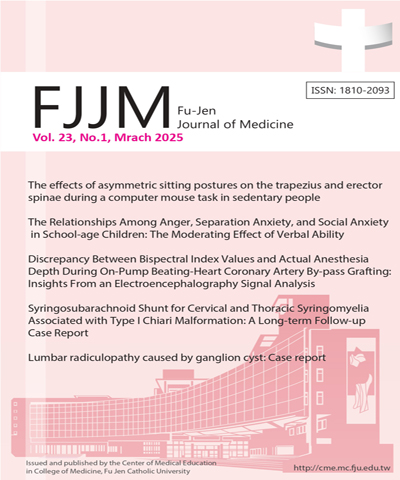
輔仁醫學期刊/Fu-Jen Journal of Medicine
輔仁大學醫學院,正常發行
選擇卷期
- 期刊
Background and Purpose: We used an animal model for light-induced retinal degeneration to investigate the possible therapeutic effect of transplanted umbilical cord mesenchymal stem cells (UMSC) in retina. Methods: Sprague-Dawley (SD) rats were exposed to cyclic, luminous light for 7 days, thereafter UMSCs were transplanted into the subretinal space. The effect was examined functionally by electroretinograph (ERG) before and after UMSC transplantation. Retinas were harvested for immunofluorescent and histological analyses to measure the changes of the outer nuclear layer (ONL) after transplantation. Results: Exposure to light for 7 days significantly reduced the amplitude of a- and b-waves of ERG, and decreased ONL thickness. After UMSC transplantation, the amplitude of a- and b-waves in UMSCtreated eyes was larger than that in the untreated eyes. The ONL of UMSC-treated retinas was thicker than that in the untreated eyes. Three weeks after transplantation, some of the grafted cells had migrated as single scattered cells into the ONL, the inner nuclear layer, and the ganglion cell layer. Grafted UMSCs were differentiated into several different retinal cells, including retinal pigmented epithelium cells, photoreceptors, amacrine cells, and horizontal cells, which were identified by retinal immunohistochemistry. Conclusion: These results demonstrate that transplantation of UMSCs improves both physiological retinal function and retinal morphology of light-induced retinopathy.
- 期刊
This retrospective observational case report details a unique finding of unilateral persistent fetal vasculature in a 36-week-old female newborn with CHARGE syndrome. The newborn presented with bilateral ocular coloboma, heart defects, genital hypoplasia, and right microtia. After pupil dilation, a large and deep excavation located centrally in her left eye was observed. The large ring-shaped coloboma was merged with the left optic disc rim. Moreover, persistent fetal vasculature (PFV) was identified from the remnant vascular stalk arising off the optic disc. An echogenic band was observed in the posterior segment of the globe extending from the optic nerve head. This paper thus suggests that PFV can appear in a patient with CHARGE syndrome, and clinicians should be aware of such rare appearance.
- 期刊
Cytomegalovirus (CMV) infection causes disease around the world. Transmission can occur in utero or anytime during the perinatal period in infants. CMV can be secreted in the breast milk of infected mothers; preterm infants are at high risk for infection. The role of infectious microorganisms in the pathogenesis of breast milk jaundice, a contributing factor to prolonged jaundice, is still not clear. We report here the case of a full-term neonate presenting indirect hyperbilirubinemia since the first 39 hours after birth. After that, she was hospitalized on four occasions and every time the laboratory results revealed idiopathic indirect hyperbilirubinemia. Neutropenia and lymphocytosis were noted during the third time, and the levels got worse by the time of the fourth admission. During each hospitalization, the jaundice was resolved after stopping breast milk intake and applying phototherapy. However, jaundice recurred upon resuming breast feeding. Finally, during the fourth hospitalization, we checked the maternal breast milk for CMV using a PCR test and saw a positive result with 8,293 copies/ mL. Given all this information, we suggested the mother to stop breastfeeding her neonate for the first 60 days of life and she complied. Thereafter, jaundice did not recur. The dilemma between benefiting from a breast milk diet and avoiding the deleterious effects of infectious diseases transmitted via the milk is an important one in caring for neonates. It is clear studies are needed but based on our experience we recommend that pediatricians remain watchful of CMV-related problems in all infants fed exclusively with breast milk and having prolonged and recurrent neonatal jaundice.
- 期刊
Calvarial cavernous hemangioma is a rare benign tumor that may mimic other cranial osteolytic lesions, such as osteosarcoma or multiple myeloma. We report a case of a 32-yearold man who presented with a painless frontal mass and associated enlargement. A computed tomographic scan showed an osteolytic lesion in the left frontal region. A tailored craniectomy followed by cranioplasty with a titanic mesh was performed, and a pathological study confirmed the diagnosis of cavernous hemangioma.
- 期刊
A 36-year-old man presented with an orbital cyst in the left eye three years after retinal detachment surgery with scleral buckling. The cyst was in the anteromedial aspect of the orbit resulting in ptosis, elevated intraocular pressure (IOP) and limited ocular motility. The cyst was totally excised and ptosis was corrected by frontalis sling procedure. Histopathology of the specimen revealed a solitary cyst lined by cuboidal epithelial cells. Some epithelial cells contained Periodic acid-Schiff (PAS)-positive granules. Accordingly, the diagnosis was a sudoriferous cyst. Sudoriferous cyst of the orbit is rare and often congenital. This case report illustrates that orbital sudoriferous cyst can develop after scleral buckling.
- 期刊
Multifaceted hemostatic mechanisms are associated with the pathophysiology of various diseases, including cardiovascular diseases. Among them, dysregulation of platelet activity is related to the progression of atherosclerosis and mainly involves platelet aggregation and decreased blood flow in the vascular endothelium. The major platelet activation pathways mediated by agonists are the arachidonic acid, adenosine diphosphate, serotonin, and nitric oxide pathways. Free radicals also affect the molecules involved in platelet aggregation. These mechanisms have been widely studied and discussed because they are inhibited by plant-based compounds that are used in complementary and alternative medicine for reducing platelet aggregation. Current antiplatelet therapy is highly effective in preventing atherothrombotic complications. Nevertheless, some patients continue to experience recurrent complications despite receiving appropriate treatment because of the pharmacokinetics and interactions of consumed drugs, the genetic backgrounds of the patients, and the increased frequency of thrombus formation. Hence, considerable research has been directed toward providing new antiplatelet drugs that exhibit superior aggregation-preventing potential but do not increase bleeding risk. In this review, we discuss unique natural antiplatelet drugs and their potential inhibition of platelet aggregation.

